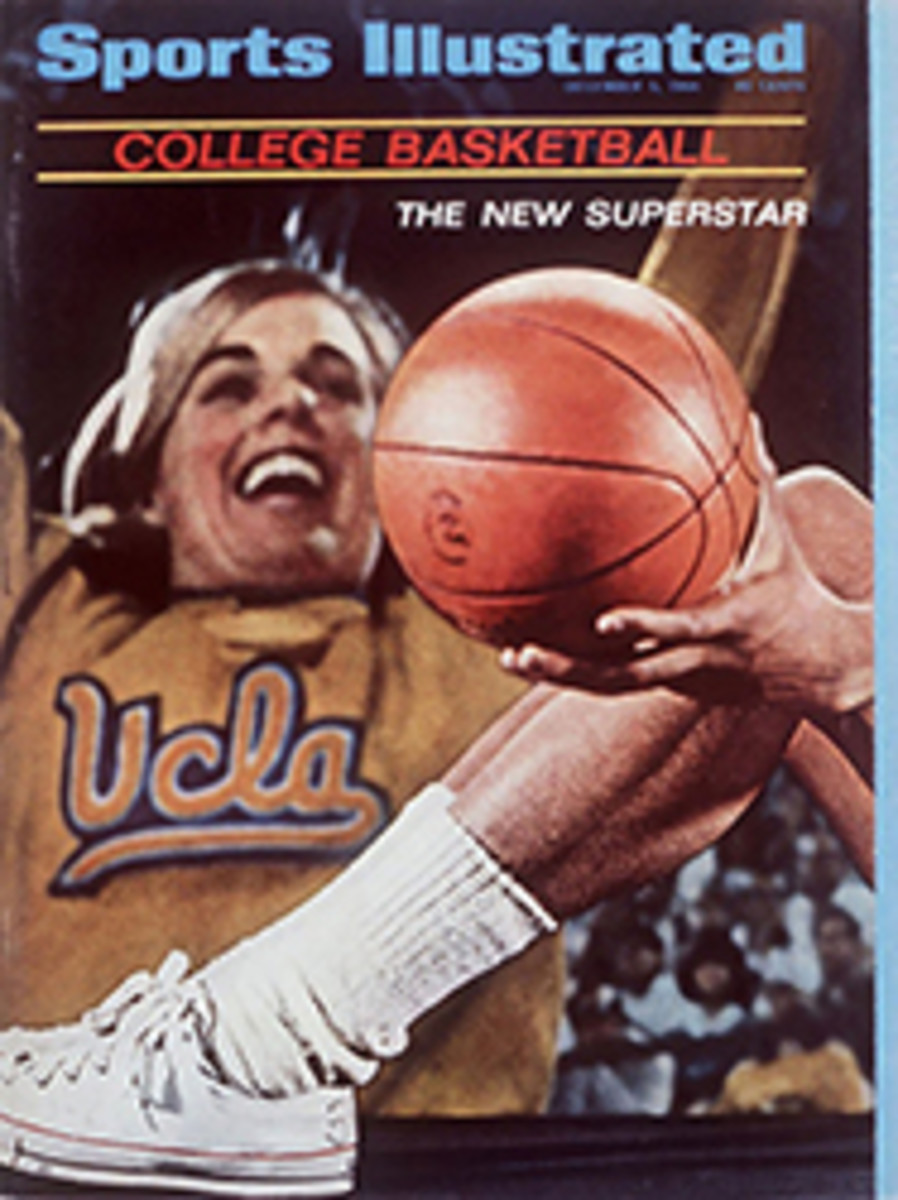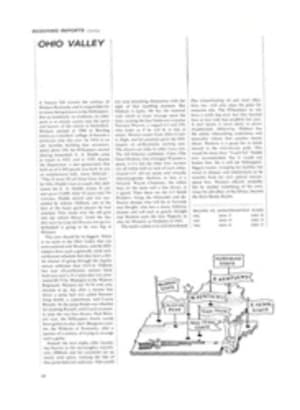
CHASING GIRLS THROUGH A PARK
It takes getting used to, seeing young women run long distances, gasping and gagging and staggering around and going down on all fours at the finish line, pink foreheads in the mud. But they are young women, all right, make no mistake. The shaved legs, the singlets that actually do a service, all that symmetry, that fragrant hair. You might just as well get used to the sight, because women are getting to like the idea. More of them are talking about it, doing it and appreciating the torture of it. And if, as Ambrose Bierce said before he went off to Mexico to get lost, a garter is "an elastic band intended to keep a woman from coming out of her stockings and desolating the countryside," then, lads, the garters are off.
They were off in St. Louis last Saturday, a hundred of them off what you might call the avant-garde of American female long-distance runners. The girls were there on a spongy, gray, leaky-nose kind of day to run a mile and a half around the lake and the planetarium at Forest Park in an event—the National AAU Women's Cross-country Championship—that everybody was not talking about and all the papers were not full of.
You see, the term "American female long-distance runner" may sound familiar, but it is a relatively new invention. For years the AAU acted as if it would rather see its girls become lumberjacks than long-distance runners, and never mind how far or how long the swimmers swam. So this was only the third national cross-country championship, and there was hardly anybody around but chicks. Even with coaches and mamas and daddies and husbands, there were more contestants (107, plus 52 child runners under 13 who ran a mile over the same course to prove a point) then there were spectators. But no matter. The young women went right ahead doing all those marvelous, important-looking things that runners do. Blowing out their cheeks to get their breathing lined up. Rotating their necks to get dekinked. Hopping up and down to get the corpuscles going. Shaking one leg and then the other to get the change out of the cuffs. Getting to know the language: "How you feeling?" "Terrible." "Good, that's how you're supposed to feel the day of the race." And, of course, sitting around the motel coffee shop bragging times and discussing times, that singular, most wearisome aspect of the track athlete's makeup. If it were not for minutes and seconds track athletes would be pretty good conversationalists.
They are an interesting group, this growing new force. Girls with names like Phyllis Fast—how you going to keep her down at the malt shop with potential for such headline alliteration as PHYLLIS FAST FINISHES FIRST?—and pretty little things like Marie Mulder (SI, May 10, 1965). Marie is 16-going-on-17 now. She has let her black hair grow long to please the latest target of her big brown eyes. "He's a pole-vaulter," she says, "and I'm not going to tell you who he is until he breaks 18 feet." She has thinned out a little and is running very well. She is definite 800-meter potential for Mexico City in 1968, and plans to run the summer away with friends at her family's cabin 7,000 feet up in the Sierra Nevada. Her goal is the Olympics. But in the meantime her coach, Brooks Johnson, a practical man, says it is good that she is trimmer, too, because she is going to be a woman much longer than she is going to be a runner.
There are other pretty little dedicated things, like Cheryl Pedlow. Cheryl is from Indianapolis, is 18, honey-blonde, blue-eyed and has never yet been mistaken for a boy. She says she once was told that a track coach did not want her to run on the same track with the boys anymore because she was a distraction. "Some distraction," she sniffed. "A bulky old sweat suit." Her passion for running has not done wonders for her social life. "The boys would say, 'Oh, yes, that's Cheri. She runs.' " Cheryl's coach, Larry Bridges, has not forgiven the Russians for sending Tamara and Irina Press over here and frightening American mothers with all those muscles.
The 107 girls in the cross-country championship had come to St. Louis primarily on pinched pennies. Most of them had some kind of team affiliation. In Friday, out Saturday, no money to spare. If they were lucky they were with a team like Will's Spikettes of Sacramento, because Will Stephens, a big ex-marine who coached Marie Mulder before her family moved to Washington, D.C., has a budget. But they came anyway, from Los Angeles, Brooklyn, Phoenix, Chicago, Frederick, Md. Some of them had their husbands, and Sara Mae Berman of Cambridge, Mass., who is "30 and a half," brought her three children, too.
You cannot appreciate the passion that distance running begets in the American female breast until you have sat at a table with Mrs. Berman and her husband, Larry, an engineer, and listened to them talk track until little Jonathan Berman, age 3, simply gives out and puts his head on the table and goes to sleep.
The Bermans, Sara and Larry, run every morning before breakfast and every evening before supper, and she never—well, hardly ever—resorts to frozen meals. They scour the country for places to run, for meets to see, for people to talk times with. Right now they are on their way to Hawaii for the AAU convention. How can they afford it? Well, they do not smoke, drink or go to movies. They keep a car six or seven years. Running and cross-country skiing make up their recreation, entertainment and sustaining love. They've even got Sara's mother on a training program. But Sara actually does not run very fast. Does she aspire to be an Olympian?" "Oh, no."
Then why run? "To improve." Sara Berman, who did not start to run until she was 25, believes that the AAU does one thing for women that it does not do for men. "It restricts women." She thinks women should be allowed to run whatever distances they are able, when they are able. "These people are always talking about the woman's constitution being different," she says, "being physiologically unsuited for distance running. I ran a race once when I was three and a half months pregnant."
Robert Hyten, an architect, track coach and sometime runner who put on the St. Louis race and considers himself "one of the young lions of the women's track-and-field lobby within the AAU, thinks that "they" are finally losing the battle to keep American women from sweating. "We're on the move," says Hyten. Who are "they?" "No one person, no name you can pin down," he says. "Just those people who have been inhibiting women's track for so long. They're old fogies. They believe that because a woman has weaker knees and weaker ankles she really should not run any distance over a quarter mile. But there has never been a thesis written, at least not to my knowledge, that concluded that women should not compete in athletics."
Sara Berman finished 33rd in Saturday's National AAU Women's Cross-country Championship race. She came muddied across the line, like most of the others, groping for the back of the runner in front of her, clinging, gasping. Larry Berman said she did fine for the first mile, but the last half mile got her and she would have to do more work. Sara is, of course, no contender, and does not claim to be. She is more like inspiration for some of the young ones, the American female distance runners of the future.
The girl for right now is Doris Brown, a 24-year-old phys-ed teacher from Seattle. She met her husband, Don, at a meet in which they were both competing, and she has been running with him ever since. She holds the world indoor-mile record (4:52), but in the present condition of women's distance running that is like setting a record for peaches canned or trading stamps licked. She runs five miles a day around a lake near Seattle; she says she loves the hills, the trees, the grass. "I don't like meets much," she says, "but I enjoy training." She has broken an arch, trained right through a case of mononucleosis, smashed a finger running in the dark and won a race while one arm was in a sling because of an injured shoulder. She endures, and she is handsomely feminine. "The femininity issue always comes up," she says, "and I tell people I do not know any girl running who is not feminine.
"Running," she argues, "is a matter of habit. Most people, even housewives, would have time to do it if they took the time and made it a habit. Most people spend their time doing—well..."
Nothing?
"Yes, but I didn't want to say it."
Doris Brown got out in front with Marie Mulder at the start of the race Saturday, and they finished that way, one-two, in the rain, with Doris 200 yards ahead. Her time was 7 minutes 51.2 seconds—see how those minutes and seconds creep in—and Hyten said he could not remember any woman ever running a cross-country race under eight minutes before. Everybody cluck-clucked and said how wonderful it was. Cheryl Pedlow finished fourth behind Natalie Rocha, 19, of Will's Spikettes. Sandra Knott, 29, the defending champion and once the only light on the American women's distance-running front, came in 10th, and announced her retirement.
Oh yes. Phyllis Fast finished 58th.
PHOTO
Churning around an early turn, the bunched field is still able to stride form fully along through the muddy going on the Forest Park course in St. Louis.
THREE PHOTOS
The one-two finishers, Doris Brown (far left) and Marie Mulder, dominated field; in fourth place was 18-year-old Cheryl Pedlow (right), who was once banned from track for "distracting boys."

